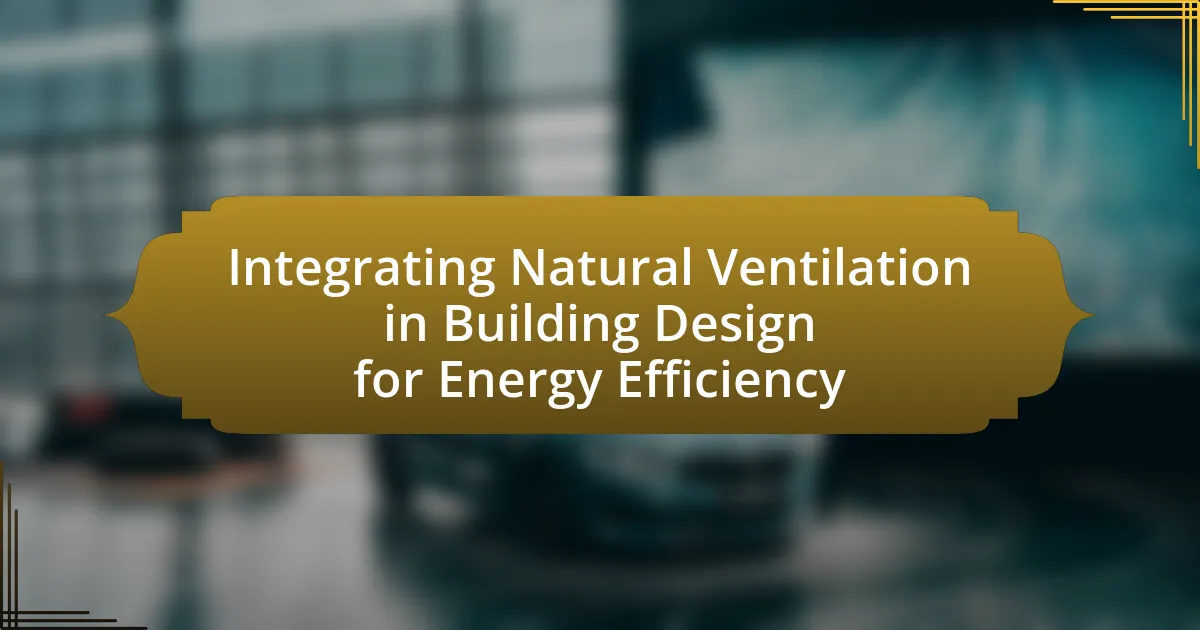Integrating natural ventilation in building design for energy efficiency focuses on utilizing natural airflow to regulate indoor temperatures and enhance air quality, thereby minimizing reliance on mechanical systems. This approach can lead to energy savings of up to 30% and promotes healthier indoor environments by improving air circulation and reducing pollutants. Key principles include leveraging temperature differences and wind pressure, while design considerations such as window placement and building orientation are crucial for optimizing airflow. The article also addresses the challenges of integrating natural ventilation, the importance of compliance with building codes, and best practices for effective implementation.

What is Integrating Natural Ventilation in Building Design for Energy Efficiency?
Integrating natural ventilation in building design for energy efficiency involves utilizing natural airflow to regulate indoor temperatures and improve air quality, thereby reducing reliance on mechanical heating and cooling systems. This approach can lead to significant energy savings; for instance, studies indicate that buildings designed with effective natural ventilation can reduce energy consumption by up to 30%. By strategically placing windows, vents, and other openings, designers can enhance airflow, allowing cooler outdoor air to enter while expelling warmer indoor air. This method not only lowers energy costs but also contributes to a healthier indoor environment, as it promotes better air circulation and reduces the buildup of indoor pollutants.
How does natural ventilation contribute to energy efficiency in buildings?
Natural ventilation enhances energy efficiency in buildings by reducing reliance on mechanical cooling and heating systems. This method utilizes natural air movement to regulate indoor temperatures, which can lead to significant energy savings; studies indicate that buildings employing natural ventilation can reduce energy consumption by up to 30%. Furthermore, natural ventilation improves indoor air quality, which can enhance occupant comfort and productivity, thereby indirectly contributing to energy efficiency by reducing the need for additional energy-intensive air purification systems.
What are the key principles of natural ventilation?
The key principles of natural ventilation include the use of temperature differences, wind pressure, and building design to facilitate air movement without mechanical systems. Temperature differences create buoyancy-driven airflow, where warm air rises and is replaced by cooler air, enhancing indoor air quality. Wind pressure, generated by external wind, can be harnessed through strategically placed openings to promote cross-ventilation. Additionally, building orientation, window placement, and the use of thermal mass can optimize airflow patterns, contributing to energy efficiency by reducing reliance on artificial cooling systems. These principles are supported by studies indicating that effective natural ventilation can lower energy consumption by up to 30% in residential buildings.
How does natural ventilation differ from mechanical ventilation?
Natural ventilation relies on natural forces, such as wind and temperature differences, to circulate air within a building, while mechanical ventilation uses powered systems, like fans and ducts, to control airflow. Natural ventilation is often more energy-efficient, as it does not require electricity to operate, whereas mechanical ventilation can consume significant energy, contributing to higher operational costs. Studies indicate that buildings designed with effective natural ventilation can reduce energy consumption by up to 50% compared to those relying solely on mechanical systems, highlighting the efficiency benefits of integrating natural ventilation in building design.
Why is natural ventilation important in modern building design?
Natural ventilation is important in modern building design because it enhances indoor air quality and reduces energy consumption. By allowing fresh air to circulate naturally, buildings can minimize reliance on mechanical ventilation systems, which often consume significant amounts of energy. Studies indicate that buildings designed with effective natural ventilation strategies can achieve energy savings of up to 30% compared to those that rely solely on mechanical systems. Additionally, natural ventilation helps regulate indoor temperatures, contributing to occupant comfort and well-being.
What environmental benefits does natural ventilation provide?
Natural ventilation provides significant environmental benefits by reducing energy consumption and improving indoor air quality. By utilizing natural airflow, buildings can minimize reliance on mechanical heating and cooling systems, leading to lower greenhouse gas emissions. Studies indicate that natural ventilation can reduce energy use by up to 30% in certain climates, thereby contributing to energy efficiency and sustainability. Additionally, it enhances indoor air quality by facilitating the exchange of stale air with fresh outdoor air, which can decrease the concentration of indoor pollutants and improve occupant health.
How does natural ventilation impact indoor air quality?
Natural ventilation significantly improves indoor air quality by facilitating the exchange of stale indoor air with fresh outdoor air. This process reduces the concentration of indoor pollutants, such as volatile organic compounds (VOCs), carbon dioxide, and particulate matter, which can accumulate in enclosed spaces. Studies indicate that buildings utilizing natural ventilation can achieve a reduction in indoor air contaminants by up to 50%, leading to healthier environments for occupants. Furthermore, natural ventilation enhances humidity control, which is crucial for preventing mold growth and maintaining overall comfort.
What challenges are associated with integrating natural ventilation?
Integrating natural ventilation presents several challenges, including variability in airflow, reliance on external weather conditions, and potential discomfort for occupants. Variability in airflow can lead to inconsistent indoor air quality, as natural ventilation depends on wind patterns and temperature differences, which can fluctuate significantly. Additionally, reliance on external weather conditions means that natural ventilation may not be effective during extreme weather events, such as heatwaves or storms, potentially compromising indoor comfort and safety. Furthermore, the design of openings for natural ventilation must consider factors such as noise, security, and pollution, which can further complicate integration efforts. These challenges necessitate careful planning and design to ensure that natural ventilation systems function effectively and meet the needs of building occupants.
What design considerations must be addressed for effective natural ventilation?
Effective natural ventilation requires careful consideration of building orientation, window placement, and airflow pathways. Building orientation should maximize exposure to prevailing winds, while window placement must facilitate cross-ventilation by aligning openings on opposite walls. Additionally, airflow pathways should be unobstructed to allow for efficient movement of air throughout the space. Research indicates that optimizing these design elements can enhance indoor air quality and reduce reliance on mechanical cooling systems, contributing to energy efficiency in buildings.
How can climate influence the effectiveness of natural ventilation?
Climate significantly influences the effectiveness of natural ventilation by determining temperature differentials, wind patterns, and humidity levels. In hot climates, higher temperature differences between indoor and outdoor air can enhance airflow, promoting effective cooling through natural ventilation. Conversely, in cold climates, the effectiveness may decrease due to reduced temperature differentials and potential heat loss. Additionally, wind patterns, which vary by region, can either facilitate or hinder airflow; areas with consistent winds can improve ventilation rates, while sheltered locations may experience stagnation. Humidity also plays a critical role; high humidity can reduce comfort levels and the effectiveness of natural ventilation systems, as moist air is less dense and may not flow as efficiently. Thus, understanding local climate conditions is essential for optimizing natural ventilation strategies in building design.

What strategies can be employed to enhance natural ventilation in buildings?
To enhance natural ventilation in buildings, strategies such as optimizing window placement, utilizing cross-ventilation, and incorporating thermal mass can be employed. Optimizing window placement involves positioning windows to maximize airflow, typically by aligning them with prevailing winds. Cross-ventilation is achieved by strategically placing openings on opposite sides of a building to create a pressure difference that facilitates air movement. Incorporating thermal mass, such as concrete or brick, helps regulate indoor temperatures and can enhance airflow by absorbing heat during the day and releasing it at night, promoting a cooler indoor environment. These strategies are supported by studies indicating that well-designed natural ventilation can reduce reliance on mechanical cooling systems, leading to energy savings and improved indoor air quality.
How can building orientation affect natural ventilation?
Building orientation significantly affects natural ventilation by influencing wind flow patterns and thermal buoyancy within a structure. Properly oriented buildings can maximize cross-ventilation by aligning openings with prevailing winds, which enhances airflow and reduces reliance on mechanical cooling systems. For instance, studies have shown that buildings oriented to capture dominant wind directions can increase air exchange rates by up to 50%, thereby improving indoor air quality and energy efficiency. Additionally, the orientation impacts solar gain, which can affect temperature differentials that drive natural ventilation, further optimizing energy use in building design.
What role do window placements play in maximizing airflow?
Window placements are crucial in maximizing airflow within a building. Properly positioned windows facilitate cross-ventilation by allowing air to flow freely from one side of a space to another, effectively enhancing indoor air quality and thermal comfort. Research indicates that aligning windows with prevailing wind directions can significantly increase airflow rates; for instance, a study published in the “Journal of Building Performance” found that strategically placed windows can improve ventilation efficiency by up to 50%. This demonstrates that thoughtful window placement is essential for optimizing natural ventilation and energy efficiency in building design.
How can architectural features facilitate natural ventilation?
Architectural features can facilitate natural ventilation by incorporating design elements such as operable windows, vents, and strategically placed openings that promote airflow. These features allow for the movement of air through a building, enhancing indoor air quality and reducing reliance on mechanical ventilation systems. For instance, the use of cross-ventilation, achieved by aligning windows on opposite sides of a room, can create a pressure difference that drives fresh air in and stale air out. Studies have shown that buildings designed with natural ventilation strategies can reduce energy consumption by up to 30%, demonstrating the effectiveness of these architectural features in promoting energy efficiency.
What technologies can support natural ventilation systems?
Technologies that can support natural ventilation systems include operable windows, ventilated facades, and automated control systems. Operable windows allow occupants to manually adjust airflow based on comfort needs, while ventilated facades enhance air circulation by utilizing external airflows. Automated control systems, such as building management systems, optimize ventilation by monitoring indoor air quality and adjusting openings accordingly. These technologies collectively improve energy efficiency by reducing reliance on mechanical cooling systems, as evidenced by studies showing that buildings with effective natural ventilation can achieve up to 30% energy savings compared to those without.
How do automated systems enhance natural ventilation effectiveness?
Automated systems enhance natural ventilation effectiveness by optimizing airflow based on real-time environmental conditions. These systems utilize sensors to monitor factors such as temperature, humidity, and indoor air quality, allowing for precise control of windows, vents, and fans. For instance, a study published in the journal “Building and Environment” demonstrated that buildings equipped with automated ventilation systems achieved up to 30% more effective airflow compared to manually operated systems, significantly improving indoor air quality and energy efficiency. This integration of technology ensures that natural ventilation is maximized when conditions are favorable, thereby reducing reliance on mechanical cooling systems and lowering energy consumption.
What role does building simulation software play in designing for natural ventilation?
Building simulation software is essential in designing for natural ventilation as it allows architects and engineers to model airflow patterns and thermal performance within a building. This software enables the analysis of various design scenarios, helping to optimize window placements, openings, and building orientation to enhance natural ventilation effectiveness. For instance, studies have shown that using simulation tools can lead to a 30% improvement in energy efficiency by maximizing the benefits of passive cooling strategies. By accurately predicting how air moves through spaces, building simulation software supports informed decision-making, ensuring that designs meet both comfort and energy efficiency goals.

What are the best practices for implementing natural ventilation in building design?
The best practices for implementing natural ventilation in building design include strategically placing windows and openings to facilitate cross-ventilation, utilizing thermal mass to regulate indoor temperatures, and designing building layouts that promote airflow. Cross-ventilation can be achieved by aligning openings on opposite sides of a space, allowing for effective air movement, which is supported by studies showing that well-placed openings can reduce reliance on mechanical cooling systems by up to 50%. Additionally, incorporating operable windows enables occupants to control airflow, enhancing comfort and energy efficiency. Proper shading devices can also minimize heat gain while allowing for ventilation, further optimizing energy use in buildings.
How can designers ensure compliance with building codes regarding natural ventilation?
Designers can ensure compliance with building codes regarding natural ventilation by thoroughly understanding and applying the specific requirements outlined in local building regulations. These codes often specify minimum ventilation rates, allowable window sizes, and placement for effective airflow. For instance, the International Building Code (IBC) mandates that natural ventilation must provide a minimum of 1 square foot of openable area for every 100 square feet of floor area in habitable spaces. By adhering to these guidelines, designers can create spaces that not only meet legal standards but also enhance energy efficiency through effective natural ventilation strategies.
What guidelines should be followed for effective natural ventilation design?
Effective natural ventilation design should prioritize the strategic placement of openings, such as windows and vents, to facilitate airflow throughout the building. This involves ensuring that openings are located on opposite sides of the space to create cross-ventilation, which can enhance air movement and improve indoor air quality. Additionally, the design should consider the local climate, as factors like wind direction and temperature variations influence ventilation effectiveness.
Research indicates that buildings designed with adequate natural ventilation can reduce energy consumption by up to 30% compared to those relying solely on mechanical systems. For instance, a study by the Lawrence Berkeley National Laboratory found that optimizing natural ventilation can significantly lower cooling loads in hot climates. Therefore, incorporating these guidelines can lead to energy-efficient building designs that leverage natural airflow for improved comfort and reduced energy use.
How can performance monitoring improve natural ventilation systems?
Performance monitoring can significantly enhance natural ventilation systems by providing real-time data on airflow, temperature, and humidity levels. This data allows for the optimization of ventilation strategies, ensuring that fresh air is effectively circulated while minimizing energy consumption. For instance, studies have shown that buildings equipped with performance monitoring systems can achieve up to 30% energy savings by adjusting ventilation rates based on actual occupancy and environmental conditions. By continuously analyzing performance metrics, building managers can identify inefficiencies and make informed adjustments, leading to improved indoor air quality and occupant comfort.
What common mistakes should be avoided when integrating natural ventilation?
Common mistakes to avoid when integrating natural ventilation include neglecting site analysis, failing to consider wind patterns, and overlooking thermal comfort. Site analysis is crucial as it determines how external factors like topography and surrounding structures influence airflow. Ignoring wind patterns can lead to ineffective ventilation strategies, as buildings may not receive adequate airflow if positioned incorrectly. Additionally, overlooking thermal comfort can result in spaces that are either too hot or too cold, undermining the intended benefits of natural ventilation. These mistakes can compromise energy efficiency and occupant comfort, highlighting the importance of thorough planning and analysis in the design process.
How can improper design lead to ineffective natural ventilation?
Improper design can lead to ineffective natural ventilation by obstructing airflow pathways and failing to optimize building orientation. For instance, if windows are not strategically placed or sized, they may not facilitate cross-ventilation, which is essential for air exchange. Additionally, the use of materials that trap heat or block airflow can exacerbate stagnant conditions indoors. Research indicates that buildings designed without considering prevailing wind patterns often experience reduced air movement, leading to discomfort and increased reliance on mechanical cooling systems. This inefficiency not only impacts occupant comfort but also undermines energy efficiency goals in building design.
What are the consequences of neglecting user needs in natural ventilation design?
Neglecting user needs in natural ventilation design can lead to inadequate indoor air quality and thermal discomfort. When user preferences and requirements are overlooked, buildings may experience poor airflow, resulting in increased levels of indoor pollutants and allergens. Studies indicate that inadequate ventilation can exacerbate health issues, such as respiratory problems and allergies, affecting occupant well-being and productivity. Furthermore, thermal discomfort due to improper ventilation can lead to increased reliance on mechanical cooling systems, ultimately undermining energy efficiency goals. This reliance can increase energy consumption by up to 30%, contradicting the primary objective of integrating natural ventilation for energy efficiency.
What practical tips can enhance the effectiveness of natural ventilation in buildings?
To enhance the effectiveness of natural ventilation in buildings, strategically position windows and openings to promote cross-ventilation. This involves aligning windows on opposite walls to create a pressure difference that facilitates airflow. Additionally, incorporating ventilated atriums or courtyards can further enhance air movement within the building. Research indicates that buildings designed with optimal window placement can achieve up to 30% energy savings by reducing reliance on mechanical cooling systems. Furthermore, using operable windows allows occupants to control airflow based on their comfort needs, thereby improving indoor air quality and thermal comfort.

Leave a Reply